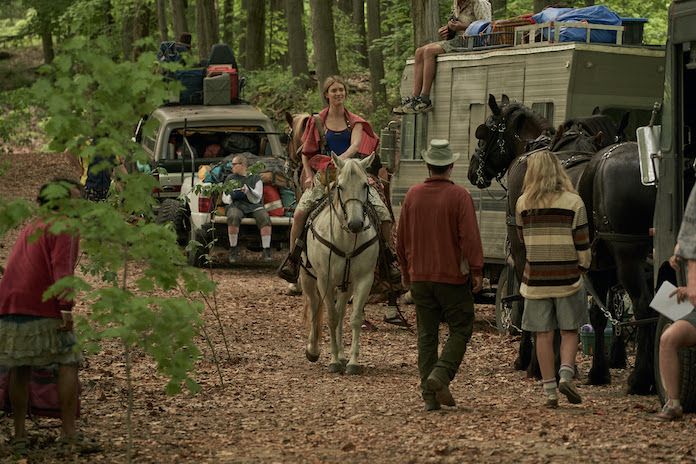
Station Eleven
HBO Max, December 16, 2021
Dec 16, 2021
Photography by Ian Watson/HBO Max
Web Exclusive
![]()
In Station Eleven, the world comes to an end within the span of a single night due to a viral influenza that is unbelievably dangerous. Adapted from Emily St. John Mandel’s bestselling novel, the 10-episode limited series is a mosaic of timelines and perspectives, following a variety of connected characters, showcasing their lives before and after the flu hit.
The series’ central thread follows Kirsten (Mackenzie Davis), a member of The Traveling Symphony, a nomadic Shakespeare-performing theatre troupe. Set twenty years after the flu arrived, Kirsten is faced with a variety of obstacles, including: trying to lead the members of the Symphony, attempting to avoid a few cults and trying to fight her own personal demons. As the series progresses, details about Kirsten’s past are revealed, as are the pasts of many other characters, and the mysterious force connecting all of them together.
Given the nature of the series, Station Eleven takes a nonlinear storytelling approach. The order of time is frequently ruptured, as the story constantly relies on flashbacks that capture moments from before the flu arrived, the night of the flu’s arrival and the first 100 days after the flu. Additionally, the series’ perspective constantly switches. It focuses on Kirsten more than anyone else, but spends a lot of time–in some cases full episodes–exploring the stories of characters who have a significant supporting role in Kirsten’s story. These two qualities make the series incredibly dense, requiring sharp attention at all times. This is at odds with the series’ start, which is daunting and dizzying, especially the opening episode’s starkness.
As Station Eleven moves forward, it becomes clear that the series’ denseness is its greatest success. It weaves the stories of its eight principal characters in a way that never feels redundant or overcomplicated. Since so much time is spent exploring their individual journeys, each character’s motivation becomes clear and differentiable early on. Each character is entirely necessary and their multiple episode-spanning narrative threads interesting to follow. These qualities make Station Eleven feel less like a narrative product and more like a puzzle, each episode slowly adding more pieces to the big picture.
Station Eleven is difficult to watch. This is due both to the fact that the series–in particular, the first episode–echoes qualities of the ongoing Coronavirus pandemic, and the fact that the series doesn’t hold back from exploring humankind’s evilness. It delivers a striking landscape of the world after the apocalypse, running rampant with constant acts of violence, an unsettling amount of cults and a general sense of untrustworthiness and disunity. Just like Kirsten, viewers are constantly on edge throughout the entire series, waiting in fear and apprehension for whatever horror could strike next. Stylistically, the episode directors do an incredible job capitalizing on this sense of dread by their constant use of unexpected, pop-out visual twists and their blurry character images in the background of shots that render characters unrecognizable. This makes viewers question if the approaching figure is a friend or a foe.
Still, the series approaches its heavy subject matter with a hopeful tone. Additionally, it strongly focuses on human’s relationship to art, showing that even in a world where everything appears to be in disarray, art has the power to bring it all back together. (www.hbomax.com/station-eleven)
Author rating: 8/10
Average reader rating: 10/10
Current Issue

Issue #72
Apr 19, 2024 Issue #72 - The ‘90s Issue with The Cardigans and Thurston Moore
Most Recent
- Premiere: ÖZLEM Shares New Video for “DURANGO” (News) — ÖZLEM
- Mitski Shares a New Video for “Star” (News) — Mitski
- Waiting in the Sky (Before the Starman Came to Earth) (Review) — David Bowie
- Challengers (Review) —
- Premiere: Eric Schroeder Shares New Track “The Kind of Wound That Never Heals” (News) — Eric Schroeder

Comments
Submit your comment
Commenting is not available in this channel entry.There are no comments for this entry yet.